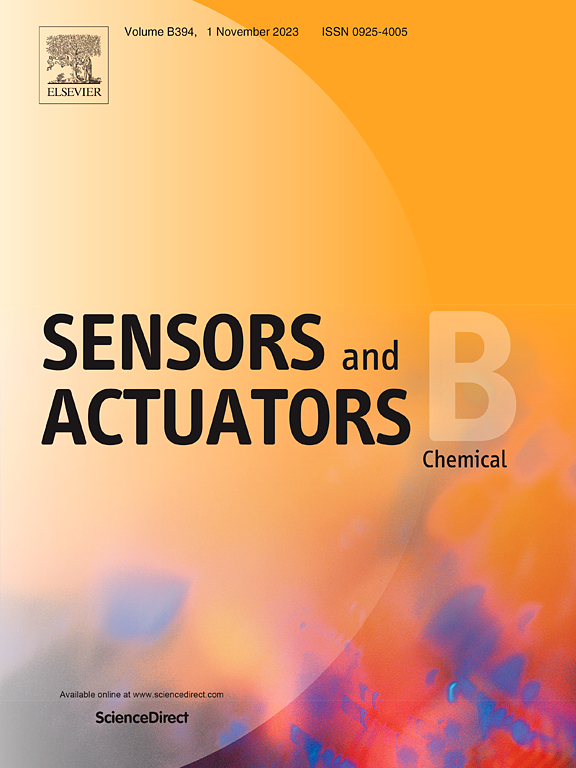一种基于苝酰二亚胺基聚合物的化学发光传感器,用于快速、灵敏、准确地检测双酚A
IF 3.7
1区 化学
Q1 CHEMISTRY, ANALYTICAL
引用次数: 0
摘要
双酚A (BPA)作为一种典型的内分泌干扰化合物,即使在极低的剂量下也对人体健康有害。化学发光(CL)法用于检测双酚a通常使用过氧化氢作为氧化剂。由于过氧化氢的不稳定性,很难保证检测的准确性。本文设计了一种基于含二硫键的苝酰二亚胺基共轭聚合物(SHPDI)和过氧单硫酸盐(PMS)的新型CL体系,用于快速、灵敏、准确地检测BPA。在该系统中,Co2+和PMS活化产生的活性氧(ROS)将SHPDI中的S-S和- SH键氧化为亚砜键,产生强烈的CL信号。同时,SHPDI中的C=O键和离域π电子也促进了PMS的分解,产生更多的ROS,有利于强CL的形成。基于SHPDI-Co(II)-PMS体系的CL传感器在10秒内对BPA具有快速灵敏的响应,在0.005 ~ 2 μM范围内CL强度显著线性降低,检出限为0.72 nM (S/N=3)。氯离子法已成功地用于桶装饮用水中痕量双酚a的直接检测。本文章由计算机程序翻译,如有差异,请以英文原文为准。

A chemiluminescence sensor based on perylene diimide-based polymer for the rapid, sensitive and accurate detection of bisphenol A
Bisphenol A (BPA), as a representative endocrine disrupting compound, is harmful to human health even at very low doses. The chemiluminescence (CL) method used to detect BPA often uses hydrogen peroxide as an oxidant. Due to the instability of hydrogen peroxide, it is difficult to ensure the accuracy of the detection. Herein, a novel CL system based on disulfide bonds-containing perylene diimide-based conjugated polymer (SHPDI) and peroxymonosulfate (PMS) was designed for the rapid, sensitive and accurate detection of BPA. In this system, reactive oxygen species (ROS) generated by Co2+ and PMS activation oxidizes the S-S and -SH bonds in SHPDI to sulfoxide bonds, resulting in a strong CL signal. Meanwhile, the C![]() O bonds and delocalized π electrons in SHPDI also promote PMS decomposition and the production of more ROS, which is beneficial for strong CL. The proposed CL sensor based on the SHPDI-Co(II)-PMS system exhibited a rapid and sensitive response to BPA in as short as 10 seconds, leading to a noticeable linear reduction in the CL intensity in the range of 0.005–2 μM with a detection limit of 0.72 nM (S/N = 3). The CL method has been successfully used for the direct detection of trace amounts of BPA in barreled drinking water.
O bonds and delocalized π electrons in SHPDI also promote PMS decomposition and the production of more ROS, which is beneficial for strong CL. The proposed CL sensor based on the SHPDI-Co(II)-PMS system exhibited a rapid and sensitive response to BPA in as short as 10 seconds, leading to a noticeable linear reduction in the CL intensity in the range of 0.005–2 μM with a detection limit of 0.72 nM (S/N = 3). The CL method has been successfully used for the direct detection of trace amounts of BPA in barreled drinking water.
求助全文
通过发布文献求助,成功后即可免费获取论文全文。
去求助
来源期刊

Sensors and Actuators B: Chemical
工程技术-电化学
CiteScore
14.60
自引率
11.90%
发文量
1776
审稿时长
3.2 months
期刊介绍:
Sensors & Actuators, B: Chemical is an international journal focused on the research and development of chemical transducers. It covers chemical sensors and biosensors, chemical actuators, and analytical microsystems. The journal is interdisciplinary, aiming to publish original works showcasing substantial advancements beyond the current state of the art in these fields, with practical applicability to solving meaningful analytical problems. Review articles are accepted by invitation from an Editor of the journal.
 求助内容:
求助内容: 应助结果提醒方式:
应助结果提醒方式:


